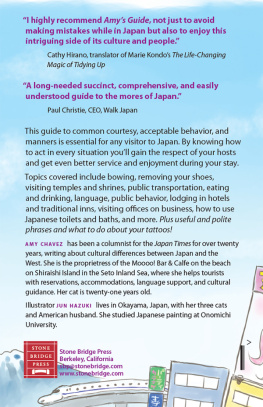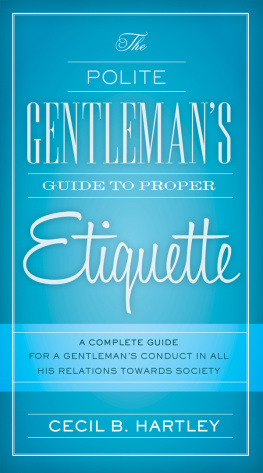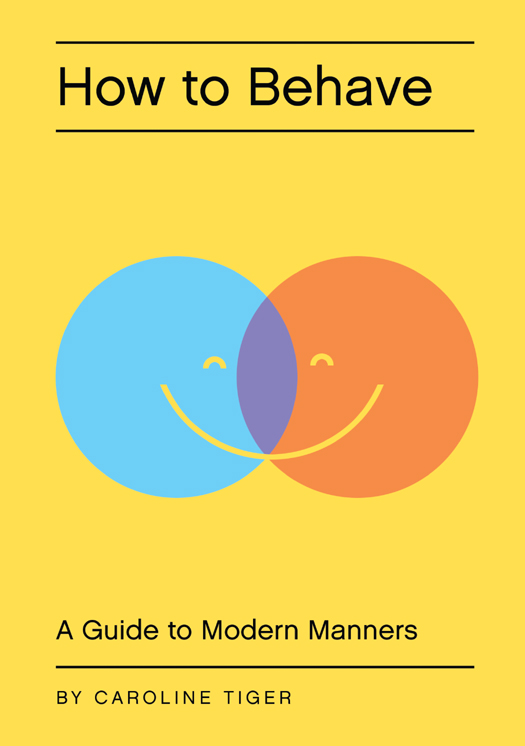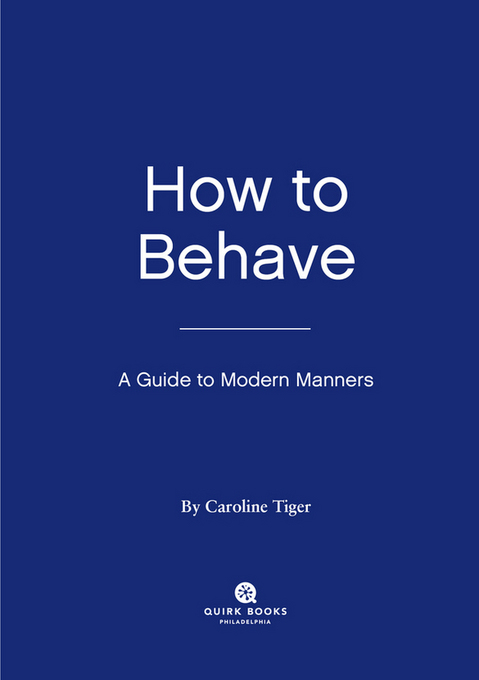Copyright 2011 by Quirk Productions, Inc.
All rights reserved. No part of this book may be reproduced in any form without written permission from the publisher.
Library of Congress Cataloging in Publication Number: 2011922692
eISBN: 978-1-59474-548-5
Designed by Doogie Horner
Production management by John J. McGurk
e-book production management by Melissa Jacobson
Quirk Books
215 Church Street
Philadelphia, PA 19106
quirkbooks.com
v3.1_r1
CONTENTS
CHAPTER 1
PLANES, TRAINS, AND AUTOMOBILES
CHAPTER 2
AT THE OFFICE
CHAPTER 3
BIG-CITY LIVING
CHAPTER 4
LEISURE TIME
CHAPTER 5
DATING, LOVE, AND SEX
CHAPTER 6
OUT ON THE TOWN
CHAPTER 7
WHILE IN CYBERSPACE
INTRODUCTION
Have you ever been to a formal dinner and not known which fork to use? We feel for you, but How to Behave wont advise you on such a superficial matterother than to ask, why are you attending such a stuffy dinner party? Tea-sipping and fork exclusivity may have been priorities for the Victorian-era leisure class, but its all the average man or woman can do today to find time to meet a friend for a drink. And chances are youll have to deal with several rude people on the way to that drinkon Facebook, in the subway, in a taxi, on the sidewalk, and maybe even at the bar.
In the twenty-first century, etiquette means something different from pinkies held at attention while sipping tea. Nowadays, etiquette is defined more by common courtesy, by showing small kindnesses to your fellow human beings during the course of everyday life. That means: No holding your rolled-up umbrella sideways so its poking passersby; no commandeering a treadmill during your gyms rush hour for 55 minutes and then forgetting to wipe off your sweat; no joining the 10-items-or-less express line at the supermarket if your basket holds more than 10 items; no tagging photos on Facebook of friends having bad hair days; no blabbing loudly on your cell phone on a train. Nitpicky? Maybe. But necessary, because modern society enforces so few rules, and people need some guidelines to keep from being inexcusably rude.
Were lucky to no longer be bound by ludicrous flatware restrictionstodays lifestyles are much freerbut that doesnt mean people should be allowed to act rudely. In How to Behave, well give you suggestions for how to respond to a litany of abysmal behaviors typically exhibited by an endless lineup of offendersthe dreaded headrest jiggler, the armrest hog, the sweat swapperas well as ways to spot your own bad behavior before you, too, join this army of boors.
In the pages that follow, you can take your choice of step-by-step techniques designed to correct many of the modern practices that define misbehavior. Provided stratagems range from polite to confrontational to passive-aggressive (to sometimes just plain weird). If you happen to choose a more aggressive strategy, consider yourself a warrior in the fight to end rudeness.
Why cant we all just get along? Because, alas, people arent always nice to one anotherand, if they were, thered be no need for this book.
CHAPTER 1
PLANES, TRAINS, AND AUTOMOBILES
Theres a lack of control that goes hand-in-hand with these modern machines. Do you really have any idea whats delaying the train or why youve been sitting on the runway for hours? You may have enough control over your car to express your impatience by leaning on the horn, but thats not going to get you out of gridlock traffic, is it? When people feel out of control, they may feel inclined to act out of control. But you can help break this cycle by adhering to a few basic rules of behavior.
IN FLIGHT
The constant overbooking of flights, the gruel they dare to call food, the surly flight attendants, the outrageous charges for luggage, the long waits while were herded through extensive security checks then forced to stand by while our shoes are pulled off and X-rayedair travel is a hassle. And nothing worsens the experience than when passengers neglect the basic rules of in-flight civility.
Armrest Decorum
The basic armrest rule is this: One to a customer, whether youre in an aisle, center, or window seat. The unclaimed center armrest is negotiable, but the center seat passenger should have first dibsafter all, this poor person is hemmed in on both sides.
What happens when youre in a cozy center seat, sandwiched between two strangers, and both the man on your left and the woman on your right are using two armrests? Are they particularly large people? No. Are they simply oblivious to your discomfort? Most likely, yes. It falls to you to point out the error of your seat companions ways.
- First, choose which seatmate to confront: the aisle sitter, who has to deal with people going up and down the aisle, bumping into him? Or the window sitter, who has as little leg room as you do? Its a tough choice, but you should address the person who seems the most pleasant and approachable.
- Once youve chosen, emit an audibly heartfelt sigh to get your seatmates attention.
- When she looks your way, engage her in small talk. Here are some starters: Where are you from? Are you traveling for business or pleasure? Do you know if we get a meal on this flight?
- Attempt to create a bond with her by lamenting the inhumane conditionsincluding the dismal grubof economy class.
- Once she begins to exhibit empathy (nods of the head, sympathetic touches of your arm), gently state, You probably didnt even realize it, but youre using two armrests. Would you mind if I used this one?
- Gaze at her dolefully. You may even want to briefly demonstrate for her how exceedingly difficult it is to spread out your book on your lap without the use of an armrest.
- Once she surrenders the armrest, thank her for her kindness and be sure to accommodate any of her wisheswithin reasonduring the rest of the flight.
When the Direct Approach Fails
If, after step 5, your seatmate refuses to surrender an elbow rests, you have license to be more aggressive. Simply maneuver her off the armrest with some quick elbow-to-elbow action.
- Plant your elbow firmly on the armrest, even if you can only fit half.
- By doing so, you will likely come into contact with your neighbors elbow and/or forearm. Do not shy away from the physical confrontation.
- Be prepared to hold your ground. Wedging your wrist and forearm against your rib cage, actively resist the pressure of your neighbors elbow. Think arm wrestlingbut, of course, with elbows.
- Decisively nudge your neighbors elbow completely off the armrest.
ETIQUETTE TIP
Improvise. Make use of props around you. Hold your in-flight beverage so that, should the armrest hog return your pressure, she risks a dousing with your Bloody Mary. (Even boors quickly recognize how unappealing it is to sit on a flight in wet clothing.)
Negotiating the Aisle
As part of their four- to six-week training program, flight attendants learn how to maneuver smoothly and efficiently up and down narrow and cramped center aisles. Passengers should take a cue from our in-flight professionals and learn to:
- Move through the cabin with minimal jostling;













